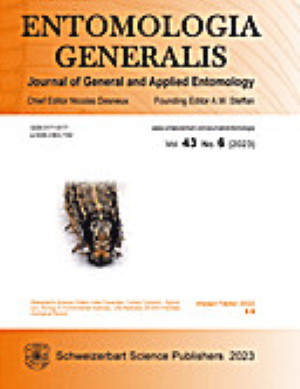Bugs and Bergmann’s rule: a cross-taxon large-scale study reveals idiosyncratic altitudinal and latitudinal body size patterns for different insect taxa
IF 4.6
1区 农林科学
Q1 ENTOMOLOGY
引用次数: 0
Abstract
Bergmann’s rule posits that an organism’s body size or mass increases with decreasing temperature. While generally established in homeotherms, Bergmann’s rule has been largely inconsistent in insects due to limited taxonomic and spatial coverage and variable sampling methods applied to the same taxonomic group. To rectify these shortfalls in tests of Bergmann’s rule in insects, we sampled ants, ichneumonid wasps, carabid beetles, and geometrid moths simultaneously from three locations (representing tropical, subtropical, and subalpine altitudinal gradients) across Yunnan, Southwest China, where temperature and productivity generally decline with latitude. We sought generalities in Bergmann’s rule in insects by investigating whether community-level altitudinal body size patterns within each location were dependent on geographic locations, microhabitats (forest canopy vs understory), focal taxa (insect families), and taxonomic scale (subfamilies within individual families). We found that altitudinal clines, when present, varied across geographic locations; carabids and geometrids showed positive clines in the tropical altitudinal gradient and negative clines in the subtropical and subalpine altitudinal gradients. Understory and canopy geometrids showed similar patterns while different subfamilies showed variable patterns. Carabid and geometrid body size patterns complied with the combined resource allocation model, which posits that the body size varies with resource availability along altitudinal and latitudinal ranges. Overall, our study revealed idiosyncratic altitudinal and latitudinal body size patterns for different insect taxa. Our study also illustrates the value of fully standardized, large-scale studies in revealing generalities (or the lack thereof) in Bergmann’s rule in insects and we suggest incorporating the natural history and biology of target groups to better explain patterns of body size variation.昆虫与贝格曼法则:一项跨类群大规模研究揭示了不同昆虫类群在海拔和纬度上的特异体型模式
伯格曼法则认为,生物体的大小或质量会随着温度的降低而增加。虽然伯格曼法则在恒温动物中普遍确立,但在昆虫中,由于分类和空间覆盖范围有限,以及对同一分类群采用的取样方法不同,伯格曼法则在很大程度上并不一致。为了弥补在昆虫中检验伯格曼法则的不足,我们在中国西南部云南的三个地点(分别代表热带、亚热带和亚高山海拔梯度)同时采集了蚂蚁、姬蜂、甲虫和尺蠖蛾的样本。我们通过研究每个地点的群落级海拔体型模式是否取决于地理位置、微生境(林冠与林下)、重点类群(昆虫科)和分类尺度(单个科内的亚科),寻求伯格曼法则在昆虫中的普遍性。我们发现,不同地理位置的海拔梯度存在差异;螨类和尺蠖在热带海拔梯度上呈现正梯度,而在亚热带和亚高山海拔梯度上呈现负梯度。树下和树冠尺蠖表现出相似的模式,而不同亚科则表现出不同的模式。食肉动物和尺蠖的体型模式符合综合资源分配模型,该模型认为体型随海拔和纬度范围内的资源可用性而变化。总之,我们的研究揭示了不同昆虫类群的海拔和纬度体型模式。我们的研究还说明了完全标准化的大规模研究在揭示伯格曼法则在昆虫中的普遍性(或缺乏普遍性)方面的价值,我们建议结合目标类群的自然史和生物学来更好地解释体型变化的模式。
本文章由计算机程序翻译,如有差异,请以英文原文为准。
求助全文
约1分钟内获得全文
求助全文
来源期刊

Entomologia Generalis
生物-昆虫学
CiteScore
7.10
自引率
18.80%
发文量
72
审稿时长
>12 weeks
期刊介绍:
Its scope covers all aspects of basic and applied research dealing with insects and more broadly with arthropods inhabiting wild, agricultural and/or urban habitats. The journal also considers research integrating various disciplines and issues within the broad field of entomology and ecology.
Entomologia Generalis publishes high quality research articles on advances in knowledge on the ecology and biology of arthropods, as well as on their importance for key ecosystems services, e.g. as biological control and pollination. The journal devotes special attention to contributions providing significant advances (i) on the fundamental knowledge and on sustainable control strategies of arthropod pests (including of stored products) and vectors of diseases, (ii) on the biology and ecology of beneficial arthropods, (iii) on the spread and impact of invasive pests, and (iv) on potential side effects of pest management methods.
Entomologia Generalis welcomes review articles on significant developments in the field of entomology. These are usually invited by the editorial board, but proposals may be sent to the Editor-in-Chief for preliminary assessment by the editorial board before formal submission to the journal. The journal also considers comments on papers published in Entomologia Generalis, as well as short notes on topics that are of broader interest.
 求助内容:
求助内容: 应助结果提醒方式:
应助结果提醒方式:


